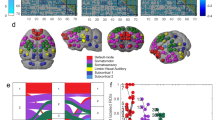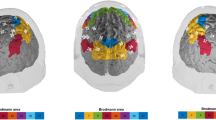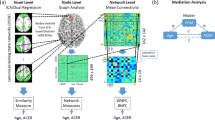Abstract
Aging is associated with changes in human brain anatomy and function and cognitive decline. Recent studies suggest the aging decline of major functional connectivity hubs in the ‘default-mode’ network (DMN). Aging effects on other networks, however, are largely unknown. We hypothesized that aging would be associated with a decline of short- and long-range functional connectivity density (FCD) hubs in the DMN. To test this hypothesis, we evaluated resting-state data sets corresponding to 913 healthy subjects from a public magnetic resonance imaging database using functional connectivity density mapping (FCDM), a voxelwise and data-driven approach, together with parallel computing. Aging was associated with pronounced long-range FCD decreases in DMN and dorsal attention network (DAN) and with increases in somatosensory and subcortical networks. Aging effects in these networks were stronger for long-range than for short-range FCD and were also detected at the level of the main functional hubs. Females had higher short- and long-range FCD in DMN and lower FCD in the somatosensory network than males, but the gender by age interaction effects were not significant for any of the networks or hubs. These findings suggest that long-range connections may be more vulnerable to aging effects than short-range connections and that, in addition to the DMN, the DAN is also sensitive to aging effects, which could underlie the deterioration of attention processes that occurs with aging.
This is a preview of subscription content, access via your institution
Access options
Subscribe to this journal
Receive 12 print issues and online access
$259.00 per year
only $21.58 per issue
Buy this article
- Purchase on Springer Link
- Instant access to full article PDF
Prices may be subject to local taxes which are calculated during checkout




Similar content being viewed by others
References
Raz N, Rodrigue KM . Differential aging of the brain: patterns, cognitive correlates and modifiers. Neurosci Biobehav Rev 2006; 30: 730–748.
Bäckman L, Nyberg L, Lindenberger U, Li S, Farde L . The correlative triad among aging, dopamine, and cognition: current status and future prospects. Neurosci Biobehav Rev 2006; 30: 791–807.
Buckner R . Memory and executive function in aging and AD: multiple factors that cause decline and reserve factors that compensate. Neuron 2004; 44: 195–208.
Logan J, Sanders A, Snyder A, Morris J, Buckner R . Under-recruitment and nonselective recruitment: dissociable neural mechanisms associated with aging. Neuron 2002; 33: 827–840.
Davis S, Dennis N, Daselaar S, Fleck M, Cabeza R . Que PASA? The posterior-anterior shift in aging. Cereb Cortex 2008; 18: 1201–1209.
Buckner R, Snyder A, Shannon B, LaRossa G, Sachs R, Fotenos A et al. Molecular, structural, and functional characterization of Alzheimer's disease: evidence for a relationship between default activity, amyloid, and memory. J Neurosci 2005; 25: 7709–7719.
Kapogiannis D, Mattson M . Disrupted energy metabolism and neuronal circuit dysfunction in cognitive impairment and Alzheimer's disease. Lancet Neurol 2011; 10: 187–198.
Buckner R, Sepulcre J, Talukdar T, Krienen F, Liu H, Hedden T et al. Cortical hubs revealed by intrinsic functional connectivity: mapping, assessment of stability, and relation to Alzheimer's disease. J Neurosci 2009; 29: 1860–1873.
Oh H, Mormino E, Madison C, Hayenga A, Smiljic A, Jagust W . Amyloid affects frontal and posterior brain networks in normal aging. Neuroimage 2011; 54: 1887–1895.
Rentz D, Locascio J, Becker J, Moran E, Eng E, Buckner R et al. Cognition, reserve, and amyloid deposition in normal aging. Ann Neurol 2010; 67: 353–364.
Dosenbach N, Nardos B, Cohen A, Fair D, Power J, Church J et al. Prediction of individual brain maturity using fMRI. Science 2010; 329: 1358–1361.
van den Heuvel M, Stam C, Boersma M, Hulshoff Pol H . Small-world and scale-free organization of voxel-based resting-state functional connectivity in the human brain. Neuroimage 2008; 43: 528–539.
Beu M, Baudrexel S, Hautzel H, Antke C, Mueller H-W . Neural traffic as voxel-based measure of cerebral functional connectivity in fMRI. J Neurosci Methods 2009; 176: 263–269.
van den Heuvel M, Mandl R, Kahn R, Hulshoff Pol H . Functionally linked resting-state networks reflect the underlying structural connectivity architecture of the human brain. Hum Brain Mapp 2009; 30: 3127–3141.
van den Heuvel M, Stam C, Kahn R, Hulshoff Pol H . Efficiency of functional brain networks and intellectual performance. J Neurosci 2009; 29: 7619–7624.
Tomasi D, Volkow N . Functional connectivity density mapping. Proc Natl Acad Sci USA 2010; 107: 9885–9890.
Tomasi D, Volkow N . Association between functional connectivity hubs and brain networks. Cereb Cortex; published online 31 January 2011; doi: 10.1093/cercor/bhq268.
Buckner R . Human functional connectivity: new tools, unresolved questions. Proc Natl Acad Sci USA 2010; 107: 10769–10770.
Biswal B, Mennes M, Zuo X, Gohel S, Kelly C, Smith S et al. Toward discovery science of human brain function. Proc Natl Acad Sci USA 2010; 107: 4734–4739.
Foerster B, Tomasi D, Caparelli E . Magnetic field shift due to mechanical vibration in functional magnetic resonance imaging. Magn Reson Med 2005; 54: 1261–1267.
Cordes D, Haughton V, Arfanakis K, Carew J, Turski P, Moritz C et al. Frequencies contributing to functional connectivity in the cerebral cortex in ‘‘resting-state’’ data. AJNR Am J Neuroradiol 2001; 22: 1326–1333.
Tomasi D, Volkow N . Functional connectivity hubs in the human brain. Neuroimage 2011 doi: 10.1016/J.Neuroimage.2011.05.024.
Worsley K, Evans A, Marrett S, Neelin P . A three-dimensional statistical analysis for CBF activation studies in human brain. J Cereb Blood Flow Metab 1992; 12: 900–918.
Fjell A, Walhovd K . Structural brain changes in aging: courses, causes and cognitive consequences. Rev Neurosci 2010; 21: 187–221.
Volkow N, Logan J, Fowler J, Wang G, Gur R, Wong C et al. Association between age-related decline in brain dopamine activity and impairment in frontal and cingulate metabolism. Am J Psychiatry 2000; 157: 75–80.
Salzman K (ed) 2005. Clinical Geriatric Psychopharmacology. Lippincott Williams & Wilkins: Pennsylvania.
Madden D, Bennett I, Song A . Cerebral white matter integrity and cognitive aging: contributions from diffusion tensor imaging. Neuropsychol Rev 2009; 19: 415–435.
Stern Y, Moeller J, Anderson K, Luber B, Zubin N, DiMauro A et al. Different brain networks mediate task performance in normal aging and AD: defining compensation. Neurology 2000; 55: 1291–1297.
Reuter-Lorenz P, Park D . Human neuroscience and the aging mind: a new look at old problems. J Gerontol B Psychol Sci Soc Sci 2010; 65: 405–415.
Craik F, Salthouse T (eds) 2000. The Handbook of Aging and Cognition. Lawrence Erlbaum Associates Inc.: Mahwah, NJ.
Wingfield A, Grossman M . Language and the aging brain: patterns of neural compensation revealed by functional brain imaging. J Neurophysiol 2006; 96: 2830–2839.
Sanfey A, Hastie R . Judgement and decision making across the adult life span: a tutorial review of psychological research. In: Park D, Schwarz N (eds) Cognitive Aging: A Primer. Psychology Press: Philadelphia, PA, 2000, p 253.
Raichle ME, Gusnard DA . Appraising the brain's energy budget. Proc Nat Acad Sci USA 2002; 99: 10237–10239.
Langbaum J, Chen K, Lee W, Reschke C, Bandy D, Fleisher A et al. Alzheimer's disease neuroimaging initiative. Neuroimage 2009; 45: 1107–1116.
Raichle ME, MacLeod AM, Snyder AZ, Powers WJ, Gusnard DA . A default mode of brain function. Proc Natl Acad Sci USA 2001; 98: 676–682.
Tomasi D, Ernst T, Caparelli E, Chang L . Common deactivation patterns during working memory and visual attention tasks: an intra-subject fMRI study at 4 Tesla. Hum Brain Mapp 2006; 27: 694–705.
Changeux J 1997. Neuronal Man. Princeton University Press: New Jersey.
Tootell R, Hadjikhani N, Vanduffel W, Liu A, Mendola J, Sereno M et al. Functional analysis of primary visual cortex (V1) in humans. Proc Natl Acad Sci USA 1998; 95: 811–817.
Damoiseaux J, Beckmann C, Arigita E, Barkhof F, Scheltens P, Stam C et al. Reduced resting-state brain activity in the ‘default network’ in normal aging. Cereb Cortex 2008; 18: 1856–1864.
Reyngoudt H, Claeys T, Vlerick L, Verleden S, Acou M, Deblaere K et al. Age-related differences in metabolites in the posterior cingulate cortex and hippocampus of normal ageing brain: A (1)H-MRS study. Eur J Radiol 2011; doi: 10.1016/j.ejrad.2011.01.106.
Andrews-Hanna J, Snyder A, Vincent J, Lustig C, Head D, Raichle M et al. Disruption of large-scale brain systems in advanced aging. Neuron 2007; 56: 924–935.
Sambataro F, Murty V, Callicott J, Tan H, Das S, Weinberger D et al. Age-related alterations in default mode network: impact on working memory performance. Neurobiol Aging 2010; 31: 839–852.
Kalpouzos G, Chételat G, Baron J, Landeau B, Mevel K, Godeau C et al. Voxel-based mapping of brain gray matter volume and glucose metabolism profiles in normal aging. Neurobiol Aging 2009; 30: 112–124.
Pardo J, Lee J, Sheikh S, Surerus-Johnson C, Shah H, Munch K et al. Where the brain grows old: decline in anterior cingulate and medial prefrontal function with normal aging. Neuroimage 2007; 35: 1231–1237.
Filley C, Cullum C . Attention and vigilance functions in normal aging. Appl Neuropsychol 1994; 1: 29–32.
Volkow N, Gur R, Wang G, Fowler J, Moberg P, Ding Y et al. Association between decline in brain dopamine activity with age and cognitive and motor impairment in healthy individuals. Am J Psychiatry 1998; 155: 344–349.
Tomasi D, Volkow N, Wang G, Wang R, Telang F, Caparelli E et al. Methylphenidate enhances brain activation and deactivation responses to visual attention and working memory tasks in healthy controls. Neuroimage 2011; 54: 3101–3110.
Schneider-Garces N, Gordon B, Brumback-Peltz C, Shin E, Lee Y, Sutton B et al. Span, CRUNCH, and beyond: working memory capacity and the aging brain. J Cogn Neurosci 2010; 22: 655–669.
Beason-Held L, Kraut M, Resnick S . I: Longitudinal changes in aging brain function. Neurobiol Aging 2008; 29: 483–496.
Blackstone C, O’Kane C, Reid E . Hereditary spastic paraplegias: membrane traffic and the motor pathway. Nat Rev Neurosci 2011; 12: 31–42.
Calhoun M, Mao Y, Roberts J, Rapp P . Reduction in hippocampal cholinergic innervation is unrelated to recognition memory impairment in aged rhesus monkeys. Comp Neurol 2004; 475: 238–246.
Marner L, Nyengaard J, Tang Y, Pakkenberg B . Marked loss of myelinated nerve fibers in the human brain with age. J Comp Neurol 2003; 462: 144–152.
Gong G, Rosa-Neto P, Carbonell F, Chen Z, He Y, Evans A . Age- and gender-related differences in the cortical anatomical network. J Neurosci 2009; 29: 15684–15693.
Gur R, Gur R, Obrist W, Hungerbuhler J, Younkin D, Rosen A et al. Sex and handedness differences in cerebral blood flow during rest and cognitive activity. Science 1982; 217: 659–661.
Baxter LJ, Mazziotta J, Phelps M, Selin C, Guze B, Fairbanks L . Cerebral glucose metabolic rates in normal human females versus normal males. Psychiatry Res 1987; 21: 237–245.
Perneczky R, Drzezga A, Diehl-Schmid J, Li Y, Kurz A . Gender differences in brain reserve: an (18)F-FDG PET study in Alzheimer's disease. J Neurol 2007; 254: 1395–1400.
Acknowledgements
This study was supported by the National Institutes of Alcohol Abuse and Alcoholism (2RO1AA09481).
Author information
Authors and Affiliations
Corresponding author
Ethics declarations
Competing interests
The authors declare no conflict of interest.
Additional information
Supplementary Information accompanies the paper on the Molecular Psychiatry website
Supplementary information
Rights and permissions
About this article
Cite this article
Tomasi, D., Volkow, N. Aging and functional brain networks. Mol Psychiatry 17, 549–558 (2012). https://doi.org/10.1038/mp.2011.81
Received:
Revised:
Accepted:
Published:
Issue Date:
DOI: https://doi.org/10.1038/mp.2011.81
Keywords
This article is cited by
-
Brain gray matter morphometry relates to onset age of bilingualism and theory of mind in young and older adults
Scientific Reports (2024)
-
The structural–functional-connectivity coupling of the aging brain
GeroScience (2024)
-
Noninvasive theta-burst stimulation of the human striatum enhances striatal activity and motor skill learning
Nature Neuroscience (2023)
-
Capturing functional connectomics using Riemannian partial least squares
Scientific Reports (2023)
-
Neural predictors of late-life suicide risk
Nature Mental Health (2023)



